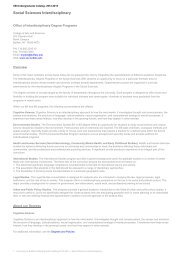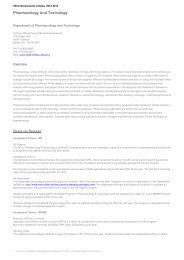Undergraduate Catalog â Print Version (PDF: 4.66MB)
Undergraduate Catalog â Print Version (PDF: 4.66MB)
Undergraduate Catalog â Print Version (PDF: 4.66MB)
- No tags were found...
Create successful ePaper yourself
Turn your PDF publications into a flip-book with our unique Google optimized e-Paper software.
2.3.4.architecture in preparation forcreative leadership within theprofession and the discipline ofarchitecture;To encourage a critical understandingof the historical,societal, material, and culturalforces that inform the builtenvironment;To prepare students to exploreemerging ideas and technologiesthat can and will have profoundeffects on the built environment;and,To provide a comprehensiveeducation through exposure torelated disciplines throughoutthe university and to encouragerigorous interaction acrossdisciplinary boundaries.Incoming students shouldprepare themselves in the areas offreehand drawing, manual drafting,figure drawing, sculpting, studio art,technical drawing, and 2-D and 3-Ddesign. Graphic techniques, modelmaking, ceramics production, metalworking, as well as many other visualskills are taught in the bachelorof science in architecture program,but students who have some earlierpreparation may find it easier tosucceed in design studio coursework.In addition, the Associationof Collegiate Schools of Architecturerecommends introductorycourses in urban studies, art, andworld history for those interested inarchitecture.Architects must be able tographically communicate their ideasvisually to their clients; therefore,design and drawing ability is helpfulfor such communication. Moreimportant is a visual orientation andthe ability to conceptualize and understandspatial relationships. Goodcommunication skills, the ability towork independently or as part of ateam, and creativity are importantqualities for anyone interested inbecoming an architect.Many of the building technologycourses and design studios requiredin the Department of Architecturedepend upon prior knowledge ofphysics and calculus, and physicsand calculus are prerequisitesfor the structures/constructioncourses in architecture. Studentsmay fulfill these prerequisites withsuccessful completion of AdvancedPlacement high school calculus andAdvanced Placement high schoolphysics, or successful completionof introductory college calculus andintroductory college physics.Basic computing skills, includingfamiliarity with personal computers,word processing, and desktop publishingare prerequisites to beginningthe sophomore year. Studentswho are unable to demonstrate thenecessary competence may be requiredto seek remedial help beforecontinuing in the undergraduateprogram. It is the responsibility ofall architecture students to haveaccess to a computer.Degrees Offered•••<strong>Undergraduate</strong>: B.S., MinorGraduate: M.Arch.Combined Graduate:M.Arch./M.U.P., M.Arch./M.B.A., M.Arch./M.F.A.Degree OptionsBachelor of Science inArchitectureThe bachelor of science in architectureis a preprofessional baccalaureatedegree designed to instillconcepts and skills upon whichprofessional architecture studiesat the graduate level are based. Itallows students to complete allprerequisites for eligibility to entera two-year accredited professionalmaster of architecture (M.Arch.)degree program. In 1994, the departmentexpanded the undergraduateprogram into a four-year, preprofessionalundergraduate degree.This format provides candidatesfor the preprofessional bachelor ofscience in architecture with a liberalexposure to the applied arts, humanities,social sciences, technologies,and aesthetic expression. Thegoal is to convey architecture as afield of study and a way of viewingthe world. A minimum of 128semester credit hours is requiredfor the preprofessional bachelor ofscience in architecture.The four-year, preprofessionalbachelor of science in architecture,without the accredited firstprofessional master of architecturedegree, is not accredited by NAAB.The preprofessional bachelor ofscience in architecture, as recognizedby NAAB, NCARB, andthe New York State EducationDepartment, is useful for thosewho desire a foundation in thefield of architecture as preparationfor either continued education inan accredited professional masterof architecture (MArch) degreeprogram or employment optionsin architecture-related professions.For additional information on theNational Architectural AccreditingBoard (NAAB), visit http://www.naab.org/. For further informationon the National Council ofArchitectural Registration Boards(NCARB), visit http://www.ncarb.org/.Most states require that anindividual intending to becomean architect hold an accreditedprofessional degree. There arethree types of professional degreesthat are accredited by the NationalArchitectural Accrediting Board(NAAB): the bachelor of architecture(B.Arch.), which typicallyrequires five years of undergraduateacademic study; the masterof architecture (M.Arch.), whichrequires a minimum of three yearsof academic study following anunrelated baccalaureate degree—or—two years following a relatedpreprofessional baccalaureate architecturedegree; and, the doctorof architecture (D.Arch.). Theseprofessional degrees are structuredto educate those who aspire toregistration/licensure as architects.The University at Buffalo is theonly campus in the State Universityof New York system to offer theaccredited professional master ofarchitecture (M.Arch.) degree.Minor in ArchitectureThe minor in architecture, anon-studio based track offered bythe Department of Architecture,provides students with a liberal exposureto the humanities, technology,social sciences, and aestheticexpression through the lenses ofthe built and the natural environments.The study of architectureoffers an indispensable backgroundfor students in most fields of studyin that it develops skills in criticalthinking and making as well as furnishingtools for interpreting andunderstanding the ways in whichwe inhabit and shape the materialworld. In addition, the minor in architecturemay enhance and provideadditional knowledge for studentsinterested in pursuing a 3+ yearaccredited professional master ofarchitecture (M.Arch.) degree uponcompletion of their baccalaureatestudies. The minor in architectureis typically completed within five tosix semesters.Architectural Licensing and Registration.To become a registeredarchitect, an individual is requiredto sit for a state-licensing architectureexam. The current licensurepolicy in the State of New York isbased, in combination, on the accumulationof credits earned from:a. Academic education; and,b. Professional/intern developmentexperience.All states and the District ofColumbia require individuals to belicensed (registered) before theymay call themselves architects andcontract to provide architecturalservices. During this time betweengraduation and becoming licensed,architecture school graduates generallywork in the profession as anintern architect under supervisionof a licensed architect who takeslegal responsibility for all work.Licensing requirements include aprofessional degree in architecture,a period of practical training or internship,and a passing score on alldivisions of the Architect RegistrationExamination (ARE).All state architectural registrationboards require a professional trainingperiod before candidates may sitfor the state-licensing architectureexam and become licensed. MostStates have adopted the trainingstandards established by the InternDevelopment Program, a branch ofthe American Institute of Architects(AIA) and the National Councilof Architectural RegistrationBoards (NCARB). These standardsstipulate broad and diversifiedtraining under the supervision ofa licensed architect over a three- tofive-year period. New graduatesusually begin as intern architectsin architectural firms, where theyassist in preparing architecturaldocuments or drawings. Internarchitects may research buildingcodes and materials or writespecifications for building materials,installation criteria, the quality offinishes, and other, related details.After completing the on-the-jobtraining period, intern architects areeligible to sit for the state-licensingarchitecture exam. The examinationtests candidates’ knowledge, skills,and ability to provide the variousservices required in the designand construction of structures.Licensing examinations are offeredin New York by the State EducationDepartment’s Office of theProfessions.At present, a candidate can sitfor the New York State licensingexam with:. The accredited first professionaldegree in architecture (UB’smaster of architecture) and aminimum of three years ofprofessional intern developmentexperience; or,ACADEMIC PROGRAMS OF STUDYUniversity at Buffalo • <strong>Undergraduate</strong> <strong>Catalog</strong> 2007-08 39












